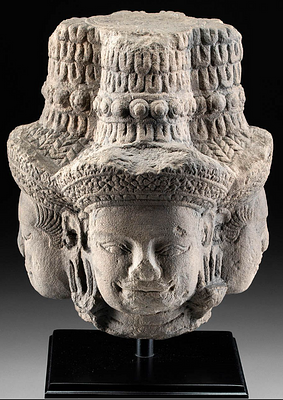19th C. Tibetan Two-Headed Damaru Drum
Lot 97b
About Seller
Artemis Fine Arts
686 S Taylor Ave, Ste 106
Louisville, CO 80027
United States
Selling antiquities, ancient and ethnographic art online since 1993, Artemis Gallery specializes in Classical Antiquities (Egyptian, Greek, Roman, Near Eastern), Asian, Pre-Columbian, African / Tribal / Oceanographic art. Our extensive inventory includes pottery, stone, metal, wood, glass and textil...Read more
Categories
Estimate:
$4,000 - $6,000
Absentee vs Live bid
Two ways to bid:
- Leave a max absentee bid and the platform will bid on your behalf up to your maximum bid during the live auction.
- Bid live during the auction and your bids will be submitted real-time to the auctioneer.
Bid Increments
| Price | Bid Increment |
|---|---|
| $0 | $25 |
| $300 | $50 |
| $1,000 | $100 |
| $2,000 | $250 |
| $5,000 | $500 |
| $10,000 | $1,000 |
| $20,000 | $2,500 |
| $50,000 | $5,000 |
| $100,000 | $10,000 |
| $200,000 | $20,000 |
About Auction
By Artemis Fine Arts
Jun 29, 2023
Set Reminder
2023-06-29 10:00:00
2023-06-29 10:00:00
America/New_York
Bidsquare
Bidsquare : Exceptional Antiquities, Ethnographic and Fine Art
https://www.bidsquare.com/auctions/artemis-gallery/exceptional-antiquities-ethnographic-and-fine-art-13031
Artemis Fine Arts info@artemisfinearts.com
Artemis Fine Arts info@artemisfinearts.com
- Lot Description
Central Asia, Tibet, ca. 19th to early 20th century CE. A two-headed drum, known as a damaru (damru), made from two human skull caps with stretched skin painted green (also probably human); joined at their apex by a leather and cotton band decorated with a 42% silver Citipati skull applique. The panels of handing cloth form a handle and decorative tassel that is worn with age and use- the once colorful cloth stained black. The damaru drum is used in both Tibetan Buddhism and Hinduism, and in the former it is used in tantric practices as just one of the sacred implements that form their rituals. Traditionally these items are made from a male and a female skull cap joined at their apex. They are often played with the right hand- the dried resin beater pellets attached to cords at the center would hit either skin face as the drum was shaken, and additional pebbles freely roll inside the skull caps as well. Size: 6.25" L x 5" W x 4.75" H (15.9 cm x 12.7 cm x 12.1 cm); silver quality: 42%
Provenance: private Hawaii collection, acquired 2000 to 2010
All items legal to buy/sell under U.S. Statute covering cultural patrimony Code 2600, CHAPTER 14, and are guaranteed to be as described or your money back.
A Certificate of Authenticity will accompany all winning bids.
We ship worldwide and handle all shipping in-house for your convenience.
#178669Age and use commensurate wear to the cloth fraying and tears to panels, nearly black with staining and textiles are stiff. Fading to green skin pigment, but intact. Drum emits sound. Drums is in overall excellent condition.Condition
- Shipping Info
-
All shipping is handled in-house for your convenience. Your invoice from Artemis Gallery will include shipping calculation instructions. If in doubt, please inquire BEFORE bidding for estimated shipping costs for individual items.
-
- Buyer's Premium



 EUR
EUR CAD
CAD AUD
AUD GBP
GBP MXN
MXN HKD
HKD CNY
CNY MYR
MYR SEK
SEK SGD
SGD CHF
CHF THB
THB














